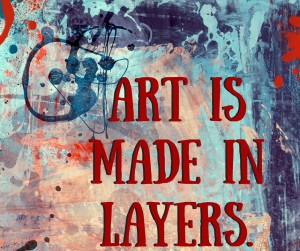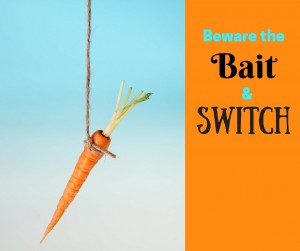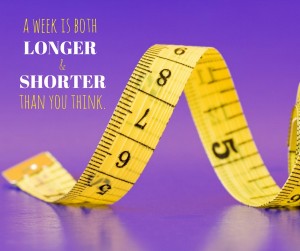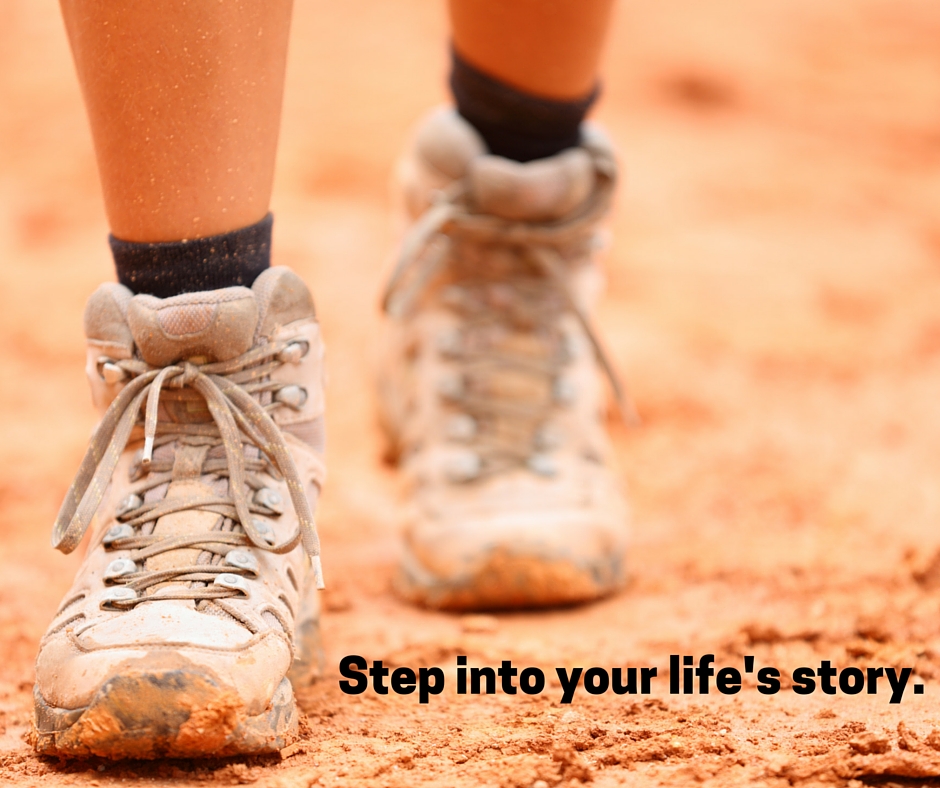by Naomi | Jan 26, 2016 | Creative Life

When I look at a finished artwork, I tend to assume the artist saw the work that way (polished, complete, refined) in their mind ahead of time. The longer I’m a writer, and the more I explore art-making of all kinds, the more deeply I understand the untruth –and unhelpfulness – of this assumption.
Every book I’ve ever written has surprised me. Every book has changed through the process of drafting and revising. And not just little changes. Huge, structural, 180 degree kinds of changes.
What if, instead of waiting until I have a clear vision, I started making art right from where I am today?
A couple weeks ago, I attended a mixed media art journaling class. To start, we laid a foundation of gesso, which is a thick white paint. Then, we wrote in the gesso with a skewer, just free-form thoughts. Then, we used a hair dryer to dry the layer. At this point, unless you looked closely, you couldn’t see a thing. Next, we chose three colors and lightly rolled a paint roller across all three paint dabs. Then, we rolled the colors onto the page in no particular pattern. Again, we dried the layer. And on and on it went, blindly for the most part. We built on the colors and patterns that showed up on the page, and an artwork started to emerge.
As I worked, I thought about improv. At Society of Young Inklings, we use an improv based approach called Writerly Play to help writers get out of their heads and into their natural, spontaneous thinking. The reason we often don’t know what to write, or think we don’t have ideas, is that we’re searching for a finished idea, one we can see fully from the outset.
Despite the fact that I teach Writerly Play all the time – I literally wrote the book on it – I forget in my own work, whether I’m writing or painting or playing guitar, that art is made in layers. I try to see the work ahead of time. I don’t allow myself to try a new art form because I look at finished examples and have no idea how to get from novice to artist. But if art is made in layers, it’s okay for me to be a novice. The first layer doesn’t even have to be visible.
Here’s how I’m going to try building my work in layers.
- I’ll start by playing with supplies. Paint, words, instruments, a camera (via my phone). I’ll explore possibilities until something catches my fancy.
- When something does catch my fancy, I’ll turn my attention to that idea and add a layer.
- After allowing the layer to settle (or dry, depending on my medium) I’ll add another layer. And another.
- I’ll keep going until my artwork is ready to show to someone else, to gain outside feedback.
- Then, I will return and keep working. Some layers will cover up ideas, some will add new ideas, but even the imprint of past work will be part of what is ultimately created.
- And at some point, I’ll pronounce the work finished.
Doesn’t that sound like an interesting experiment? I think this process can work whether the artwork is a song or a collage or a book. Following these steps will cause me to start earlier, work more intuitively, and come up with work that has richness and depth.
I can’t wait to try it. Anyone with me? If you are, let’s chat about what we discover. Share below, or on social media, wherever you want to engage. I’m @naomikinsman, and Naomi Kinsman on Facebook.
by Naomi | Jan 25, 2016 | Tools & Apps
Naomi’s Playlist is an eclectic collection of tools that help me approach my work as play. My hope is that they’ll do the same for you!

Object: Staying connected with and investing focused energy in friends and colleagues.
What Didn’t Work: Trying to remember to reach out. Only reaching out when I needed something specific. Feeling like I was always losing track of people. Wishing the people I care about knew I was thinking of them. Feeling like a failure because when I did think about reaching out, too much time had passed since the last time I’d connected.
My Aha! Moment: While listening to Dorie Clark’s book, Stand Out, on Audible, I made a few connections I hadn’t made before. First, I realized I was so busy getting things done, I wasn’t bothering to share my broader vision. Second, I realized that there are a lot of people who would want to be included in that vision–people who are already in my community–who I was excluding, simply because I hadn’t thought to reach out. Third, I realized that to actually accomplish something meaningful, people are what count.
However, in the rush of everyday life, it’s too easy to be swept into the tasks that show up in your inbox rather than to remember the bigger picture (and much more important) tasks of staying in touch. So, I started exploring options, and that’s when I found Cloze.
How I Play:
• Cloze is a CRM (customer relationship manager) for everyday people. I use the app on my iPhone, but there is also a web interface and an app for Android.
• As a small business owner, I also use a high-powered CRM, but for daily interactions, I use Cloze. Close creates a daily agenda that reminds me to check in with people, populating the list with contacts based on how often I usually interact with them.
• I’ve gone through and started to categorize contacts. Then, I can assign a certain timing to those contacts so I start interacting more regularly with people I haven’t been contacting enough.
• When someone pops up on my daily agenda, I send a quick email saying hello. It’s always nice to have a personal, friendly email in the sea of requests that floods into an inbox–a breath of fresh air.
Player’s Notes:
• Tags allow you to create specialized lists. For instance, I created a list of experts with whom I want to network. I pull up this list and use the Twitter feed and Linkedin functions of Cloze to see what they’re up to and to help support them through retweeting or linking to their posts.
• Even though Cloze automatically sorts people by using your inbox and interactions with them on social media, the possibilities of this powerful tool are a little overwhelming. Rather than trying to set everything up ahead of time, I do a little each week.
Take it to the Next Level:
• Cloze has functions I haven’t explored yet, including project management and other tools. As time allows, I’m looking forward to exploring those, too. Maybe you can share your tips and tricks with me, if you try it out!
• Cloze allows you to export a list to csv, which can allow you to take a more simplified look at your full list of contacts. Try pulling a list and reviewing for additional networking possibilities.
by Naomi | Jan 19, 2016 | Creative Life

Yesterday, I finished a draft of a book. The project had a tight deadline and required my full concentration. Finishing was a big deal––a cause for true celebration. So, what happened the minute I reached my goal? My mind leapt to all the other things, you know, all those things I hadn’t been doing because I’d been concentrating on the book.
Fortunately, I caught myself in the middle of my “yes, but” thinking, and I remembered to stop, to celebrate what I HAD done, rather than focusing on all that I hadn’t finished. I don’t always catch myself, though.
In fact, I do this kind of bait and switch thing all the time. Here’s how it goes.
- I set a goal for my day.
- Sometimes, the goal is reasonable and I reach it.
- If I do reach my goal, total amnesia sets in about the agreement I made with myself.
- As I close my eyes to go to sleep, I scold myself for the laundry list of other things that are still undone.
Sound familiar?
The trouble is there are ALWAYS more things to do. Emails are always arriving in your inbox. Your laundry is being worn and becoming dirty. Your body is burning up the calories from your last meal and soon it will be time to shop for groceries and cook again. Don’t get me started on the dishes. Your dog is splashing around in mud puddles and tracking dirt into the house and your cat is shedding. Dust-bunnies are gathering. One assignment is done, and the next shows up.
It’s kind of funny––the way we demand the impossible of ourselves––but it’s also not funny at all. Because what’s really going on here is that we’re breaking trust with ourselves. We’re wearing down that strong inner muscle that allows us to achieve goals in the first place. Think about how it would work with a child. We ask the child to make their bed, and then when they proudly present their neatly-made bed, we point out their mid-process art project strewn across the desk. “Why didn’t you clean those up?” Because they were busy making the bed!
How motivated is that child going to be next time we ask them to make their bed?
We break trust with ourselves when we set one goal and score ourselves on another.
Too much broken trust, and I feel lackluster, ho-hum, meh. I can’t drum up the energy to reach for another goal. Of course I can’t. I’ve taught myself there will be no joy in the achieving of that goal. All there will be is more work. To me, that sounds like a recipe for a meaningless trudge through life.
So, today, I’m thinking about my trust-muscle, and how to develop it. How can I celebrate what has been done? How can I learn with my heart (not just my head) that when I’m doing one thing, that means I’m not doing any of the others? And how can I create systems that help me adjust and rebalance quickly after I’ve blocked out the world to reach for a really important goal?
One way I do this is to think about the six main areas of my life: core, commitment, creativity, connection, cultivation and casting dreams. I wrote about them a while back, and will probably write about them more soon. For now, maybe I’ll figure out a way to celebrate by investing time and attention in one or two of the areas that hasn’t been tended for a while. Maybe I can spend some time with a friend (connection) and make something just for the fun of it (creativity). Yep, that sounds like an excellent way to celebrate.
How about you? Have you baited and switched on yourself recently? What might you do to re-build some inner trust?
by Naomi | Jan 12, 2016 | Creative Life
 A week is both longer and shorter than you think.
A week is both longer and shorter than you think.
If you’re anything like me, you might set out on a Monday to do a laundry list of things, thinking that by Friday you’ll surely have time to complete them. Come Friday, you review the list and ugh! At least half of it remains.
As I was considering this sad state of affairs this past weekend, I noticed something interesting. While many boxes on my to-do list weren’t checked off, during the week I’d had a collection of small, interesting encounters. These encounters had started to shift things in my larger world. In fact, some challenged I’d have expected to work on for the rest of the year now had solutions right around the corner.
Which led me to ask myself: Is my to-do list full of the wrong things?
If PEOPLE can cause challenges to untangle, maybe I should spend more time making myself available. Maybe all that time spent on sorting, handling, drafting, researching, planning … maybe it could all be a little less important, if I only made myself more available.
Now, I’m sure that aimless availability wouldn’t have been helpful. But, since I’d spent a good amount of time in December thinking about my big-picture goals, this week, I was primed to pay attention to those things which might make the most big-picture difference.
Here’s a recipe for making progress that I plan to explore. I’ll let you know how it goes.
- Review my goals on Friday, note any progress over the week.
- Identify the chief obstacles. Right now, what’s immediately in the way? What do I need next?
- In relation to those needs and obstacles, think about the people around me. Consider the resources available through friends, co-workers, newcomers who have been suggested to me or who have just crossed my path. Or even online experts–bloggers, podcasters, and more.
- Decide: Who might I reach out to this week? Where might I go this week to encounter someone who just may have a new idea or solution for me?
When I go somewhere new or discuss a problem with a new person, I often find that creative doors and windows are thrown open. Solutions I didn’t expect alight on my shoulders with hardly any effort on my part. It almost feels like cheating. Except, it isn’t. I’m getting out of my own way, looking past my all important to-do list, and realizing that most of the time, the solution is closer than we think. All we have to do is ask.
So, that’s what I’m going to do. A whole lot more asking. Because I may not be able to check off all those to-dos in a week, but if I can ask the right question and toss most of those boxes off my list … well, I’d do that in a heartbeat!
How about you?
by Naomi | Jan 5, 2016 | Creative Life
 Do stories matter? When I come up against this question, I feel like I’m trying to defend an immutable law of nature, such as, say … gravity. I do that defensive thing and throw out a bunch of words about connection and empathy and imagination, my voice rising with passion. All the while, the person across from me nods and then says something along the lines of, “Yes, but in practical terms …” or “What will get her into college …” or “Where we need to spend our time is …”
Do stories matter? When I come up against this question, I feel like I’m trying to defend an immutable law of nature, such as, say … gravity. I do that defensive thing and throw out a bunch of words about connection and empathy and imagination, my voice rising with passion. All the while, the person across from me nods and then says something along the lines of, “Yes, but in practical terms …” or “What will get her into college …” or “Where we need to spend our time is …”
What breaks my heart is the reply I hear most often: That’s great for you, but I’m not a writer.
The more I think about this commonly held belief, the more it bothers me.
Being able to shape a story is like having a superpower. Unlike most superpowers, this power is completely accessible to anyone willing to learn. How can so many people–the majority of people–believe that writing is for other (more creative) people?
Here’s what story-telling gives you the power to do:
- Make someone laugh
- Enchant someone, or a group of someones
- Cause someone to feel what you feel
- Change someone’s mind, belief system, or actions
- Find a pattern of meaning in your own experiences
- Change your own actions so you can live a more meaningful story
The list could go on and on. The trouble is, this powerful tool dresses itself in whimsy. Stories are so … fun. We consume them for entertainment. It’s so very easy to become convinced that nearly everything else is more important.
Is everything else more important?
Stories connect us, one heart to another. Whether we’re telling real-life narratives or shaping fiction, stories come from our lived experience. When we tell stories, we slow down long enough to pay attention. We find words to express what we see, what we feel, what we believe. We see where change may be needed, and what we can do to effect that change. Rather than an endless stream of experiences, we see that our lives have meaning.
Your life has meaning.
Don’t miss that crucial, beautiful discovery, just because someone told you that you didn’t have writing “skill.” We’re all story-tellers … we live in the midst of a cacophony of stories. Ours and those of everyone around us.
I’m on a mission, friends. I don’t want anyone to get lost in the foggy mess of life. I want to shout this truth from the rooftops: We all live stories–stories full of potential and challenges and victories. Just like any character in a story, our decisions matter. Every single one matters. What decisions will you make?
Some of you already do a lot of writing, but some of you do not. If you’re one of those who does not, would you do one thing for me? Think about a recent life experience. Break it into simple parts: beginning, middle and end. Was there a problem in it, or a challenge? Was any lesson learned? If you had to put the meaning of that experience into a sentence or two, what would it be? Now, set a timer for just five minutes and write that story.
If you are so inclined, share with me how the writing went. I’d love to help and support you on your creative journey.
P.S. I love this video on why stories matter.




 A week is both longer and shorter than you think.
A week is both longer and shorter than you think. Do stories matter? When I come up against this question, I feel like I’m trying to defend an immutable law of nature, such as, say … gravity. I do that defensive thing and throw out a bunch of words about connection and empathy and imagination, my voice rising with passion. All the while, the person across from me nods and then says something along the lines of, “Yes, but in practical terms …” or “What will get her into college …” or “Where we need to spend our time is …”
Do stories matter? When I come up against this question, I feel like I’m trying to defend an immutable law of nature, such as, say … gravity. I do that defensive thing and throw out a bunch of words about connection and empathy and imagination, my voice rising with passion. All the while, the person across from me nods and then says something along the lines of, “Yes, but in practical terms …” or “What will get her into college …” or “Where we need to spend our time is …”